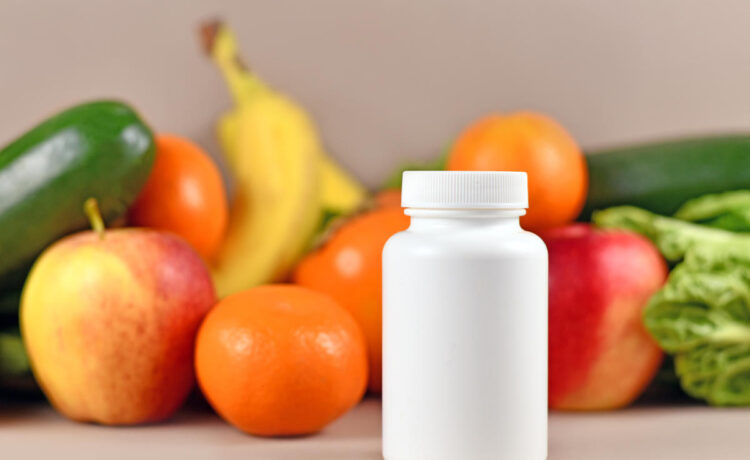Smoking used to be the leading cause of death in the U.S. Now, it’s poor diet, according to Anand Parekh, chief medical adviser at the think tank Bipartisan Policy Center.
He and others spoke about the growing trend of treating food with the same level of importance as medicine in a person’s health outcomes at a recent summit in Washington, D.C. hosted by the U.S. Department of Health and Human Services (HHS).
The idea, known as “food as medicine,” has been pushed into focus by the Biden administration since 2022, with the hopes of incentivizing the private sector to do more.
That includes everything from public-private partnerships for food delivery and health screenings, to encouraging food companies to locate in food deserts. It’s all in an effort to reduce costly hospital visits, improve Americans’ health, and provide better quality of life for all Americans, regardless of their socioeconomic status.
Such strategies could potentially avert 1.6 million hospitalizations and provide net cost savings of $13.6 billion annually for insurance, according to a Tufts University study.
Companies like Instacart and Uber (UBER), are ahead of the game, launching health-focused initiatives for food delivery that can earn them a share of the more than $4 trillion healthcare economy. But neither has revealed the level of success (or failure) of their respective efforts to date, and declined to do so to Yahoo Finance in separate interviews.
Food as medicine
The idea that healthier food and food consumption habits can impact a person’s health is not new, and has been part of what are known as social determinants of health – the idea that a person’s housing, food, job and transportation directly impacts and predicts their health.
“If someone is food insecure, they likely also have other social determinants of health affecting them. If that other determinant is not having transportation, then Uber is solving that problem simultaneously,” said Uber Health global head Caitlin Donovan.
But the government’s efforts have helped create more awareness. The conversation first began during President Barack Obama’s administration, and continued through several pilot programs by insurers and hospital organizations over the years.
And data continue to mount in the space proving the benefit.
Instacart recently announced results from a one-year partnership with digital health platform Good Measures, which coordinates with employers and commercial Medicare and Medicaid plans.
After one year, 68% of participants who received groceries that were medically tailored – or recommended by a healthcare professional to suit a person’s health needs – showed improved or level blood pressure.
The duo found, from members in six health plans, that after a year of supporting healthy food and cooking habits and recommending and delivering health foods, 72% of members lost or maintained weight. The average weight loss was 4.5% of body weight. The companies also found improvements for patients with high blood pressure.
Despite similar positive results and data over the years, programs that address food insecurity or food as medicine have languished as pilots, or been the burden of small non-profit providers, over the years.
But the current administration’s strategy isn’t any better. It is susceptible to the ongoing temporary use of taxpayer funding and philanthropy, as well as any changes in priority that occur with a new administration in the future.


The Walmart effect
To date, any food-related health efforts have put the burden on local community organizations, like Meals on Wheels and food pantries. They rely on donations, grant funding or self-pay in order to survive, and have operated this way for decades.
One of the biggest barriers to growing and scaling beyond local impact has been funding, but also the lack of a coordinated national network.
That’s where tech companies like Uber and Instacart, who rely on gig workers to create that network, have come in.
“One company, one organization, one non-profit is not going to singularly be able to address it all. The reality is that the pandemic did present a lot of opportunities for new companies, especially those who were focused on that quick transition from business to consumer direct, and to-the-door deliveries. Tech companies were especially able to capitalize on that, much more quickly than bigger (legacy) organizations (in the space),” said Ipyana Spencer, chief health officer at Meals on Wheels America.
“The companies that are able to provide a uniform distribution of product do have a leg up on community-based organizations,” she told Yahoo Finance.
It’s why Meals on Wheels decided to band together all the separate efforts across the country, in order to be a player in the ongoing programs with the government and health insurers.
“No health plan wants to coordinate with 50 community-based organizations on the ground, go through that contracting process. And so by creating Meals on Wheels Health, what we’ve done is create a single point of contact to access the broader member network,” Spencer said.
Instacart, for example, told Yahoo Finance it reaches more than 95% of U.S. households, including 93% in food deserts, through its network of more than 80,000 stores.
The question is, will it and other startups, like FreshRx – which has partnered with local food organizations to increase healthy food access with government grant money – be able to survive in a world, if and when, the federal government’s interest wanes?
Uber had been solving the transportation problem for years before entering the food and medicine space, partnering with hospitals and health systems to provide rides to patients in need in order to increase adherence to appointments and health checkups. It has also recently added a prescription delivery and a grocery delivery service, as both Medicare and Medicaid cover these services, as part of the Uber Eats program – which had been struggling to find profits for years.
“We were originally built for providers and care coordinators to request things on behalf of patients,” Uber’s Donovan told Yahoo Finance in an interview.
She added that “scaled companies like Uber Health that are playing in this space that make it much easier to make something work, not just one city with one food bank —which is noble work—but isn’t national, so (Uber) can take learnings and scale them much faster.”
Instacart, meanwhile, is by its own admission, a “new player in the space.” A grocery shopping and delivery platform, like Uber, Instacart relies on gig workers to go to grocery retailers and shop for the customer as well as deliver the items. It became popular during the pandemic, like many other such companies. But, unlike Uber, its health initiative was launched directly with the help of the federal government.
“We launched Instacart Health with the support of the White House National Strategy on Hunger, Nutrition and Health in late 2022. Since then, we’ve formalized partnerships with numerous payers, providers, nonprofits and local governments to launch nutrition access and food as medicine programs using our technology,” Instacart’s vice president and general manager of health, Sarah Mastrorocco, told Yahoo Finance.
It has now launched a new public-private partnership with HHS to help the agency learn more about the needs of individuals who are food insecure and how to best serve them.
The challenge the government will have is in incentivizing the private sector to launch more partnerships, and to stay in a market with little or no guarantee of profit.
U.S. Health Sec. Xavier Becerra told Yahoo Finance he is confident the industry will follow the government’s lead.
“I know the folks at Instacart are interested in helping us reach the industry and get further partners, and I know they’re interested because who doesn’t want more customers?” Becerra said.
“We want to make sure that we encourage the food industry to locate in what are currently food deserts,” he added.
But companies will have to contend with going into areas where “oftentimes, you just decide you’re not going to make it in the black,” Becerra said, referring to the industry term for profits.
Meals on Wheels’ Spencer echoed Becerra, warning the profit margins could narrow down or become non-existent. Simultaneously, the tech platforms swooping in need to be cognizant of the local efforts, and not, in the way Walmart was feared to do in rural America, erase the existing infrastructure.
“I would only hope that in the process of supporting innovation, that policymakers, that regulators, are not decimating the infrastructure that needs to continue to exist, that supports programs like Meals on Wheels, like other community-based organizations,” she said.
“For-profits have a purpose…and when they leave because ethos market is no longer profitable, at the end of the day there will still be seniors and families in need and who need help,” Spencer added.


Funding and food
To-date, no company or organiation has been able to scale up the solution to a nation-wide, long-term program. How to continue funding efforts that show promise and benefit remains a quandry.
In part, it’s because food insecurity and food as medicine have many different definitions. Uber’s Donavan and Meals on Wheels’ Spencer explained it as three different buckets. The first is not having food a for a long period of time, the other is not having the right type of food per a person’s health conditions, and the last is a temporary situation like in a post-surgery phase or, in the case of veterans, in the transition phase out of the military – ofthen the most vulnerable time for them.
The U.S. Department of Veterans Affairs (VA) is working with the Rockefeller Foundation on a two-year pilot to provide $100 debit cards and cooking training to veterans who are eligible when screened. The VA has already signed up about 200 veterans in six months, of a goal of 500.
Unlike other programs, the VA has the authority to ensure the benefit becomes permanent, if the evidence it collects during the pilot informs it to do so. That’s because it serves as a health system, but also as a payer of the health system.
“We can decide as a healthcare system to invest in something that has good outcomes for veterans, so we’re not in the mindset here of having pilots that last forever,” said undersecretary Dr. Shereef Elnahal.
“The Secretary has substantial regulatory authority over what we define as needed care in…our medical benefits package. So we can determine, as an agency, based on the recommendation from our clinicians, the evidence and the research, what should belong in a medical benefits package.
And we rarely see any Secretary take things away,” Elnahal told Yahoo Finance, on the potential of a change in administration.
HHS, meanwhile, is advocating for expansion of Medicaid in states that have not already done so – which requires the states to commit more federally-matched taxpayer dollars – in order to use 1115 waivers, which provide flexibility to spend dollars on pilot programs, in order to stand up more food efforts that target behavior change and access needs, unlike the existing food and nutrition programs known as SNAP and WIC. The recent partnership with the Rockefeller Foundation is another avenue for ongoing funding.
But there is another compounding problem. The reason why food insecurity exists is also because of food deserts in the U.S. In 2021, the U.S. Department of Agriculture determined that 12.8% of Americans, or more than 39 million people, live in food deserts.
The food problem is a result of how Americas expect to grow and pay for food. Something USDA Sec. Thomas Valsick says needs to change.
“We’ve lost 437,000 farms in the last 40 years in this country. We’ve lost 141 million acres of farmland. And I think we need to start asking the question of the country whether we are ok with that. Whether we are ok with the societal price we pay when we reduce rural communities and small town opportunities,” Vilsack said.
The discussion of food as medicine is a really good opportunity for us to begin a shift away from production model of agriculture, where the focus has been — because the country has asked farmers to produce more — to a focus that now recognizes that so many small and mid-sized producers need different sources of income and different streams of income in order to survive, in order to thrive,” Vilsack said.
And ensuring that the programs that begin now continue is something both the public and private sector are focused on.
Acknowledging that it is not feasible to expect it to be a fully socialized program.
“What health plans are trying to figure out is how to try and get it reimbursed. I think that’s what the government is also trying to figure out. What is it that we actually need to do to ensure that this can be offered in a way that is…I don’t think anyone wants to take on the expenditure of providing food for every meal for every individual who has some sort of food insecurity,” Meals on Wheels’ Spencer said.
“They’re not trying to be the default food provider for all of their members. It’s not economically feasible, it’s just not realistic, and the government hasn’t figured out, broadly, how to address non-medical, non-clinical benefits that are going to be offered to those individuals that are in Medicaid, that are in Medicare and even commercial insurance – which is probably the most robust and innovative set of benefits that you’ll see out there,” she added.
Or, as Becerra put it, at the event: “We know we’ve got to get away, at HHS, from thinking of healthcare as what happens between the walls of a doctor’s office or in a hospital. We don’t want to be constricted, and we don’t want our dollars to be constricted to just paying for — through Medicaid, Medicare, ACA —a visit to the doctor or a stay in the hospital.”
Anjalee Khemlani is the senior health reporter at Yahoo Finance, covering all things pharma, insurance, care services, digital health, PBMs, and health policy and politics. Follow Anjalee on all social media platforms @AnjKhem.














